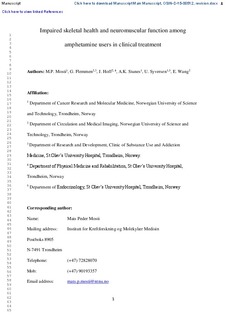| dc.contributor.author | Mosti, Mats Peder | |
| dc.contributor.author | Flemmen, Grete | |
| dc.contributor.author | Hoff, Jan | |
| dc.contributor.author | Stunes, Astrid Kamilla | |
| dc.contributor.author | Syversen, Unni | |
| dc.contributor.author | Wang, Eivind | |
| dc.date.accessioned | 2016-11-29T14:16:06Z | |
| dc.date.accessioned | 2017-02-22T07:45:32Z | |
| dc.date.available | 2016-11-29T14:16:06Z | |
| dc.date.available | 2017-02-22T07:45:32Z | |
| dc.date.issued | 2016 | |
| dc.identifier.citation | Osteoporosis International 2016, 27(3):1003-1010 | nb_NO |
| dc.identifier.issn | 0937-941X | |
| dc.identifier.uri | http://hdl.handle.net/11250/2431663 | |
| dc.description.abstract | Summary
This study examined musculoskeletal health in amphetamine users, compared with healthy age-matched controls. We show that amphetamine users have reduced bone mass at several skeletal sites and attenuated maximal muscle strength and force development capacity in the lower extremities.
Introduction
Amphetamine use may cause poor bone quality and elevated risk of osteoporosis. The purpose of this study was to investigate whether amphetamine users exhibit reduced regional and whole body bone mineral density (BMD), altered bone metabolism, and how muscle function may relate to the patient groups’ skeletal health.
Methods
We assessed hip, lumbar spine and whole body BMD, and trabecular bone score (TBS) by dual x-ray absorptiometry (DXA), and bone metabolism markers in serum and maximal strength and force development capacity in 36 amphetamine users (25 men, 30 ± 7 years; 11 women 35 ± 10 years) and in 37 healthy controls (23 men, 31 ± 9 years; 14 women, 35 ± 7 years).
Results
Whole body BMD was lower in amphetamine users (8 % in males and 7 % females, p < 0.01), as were BMD at the total hip and sub-regions of the hip (9–11 % in men and 10–11 % in women, p < 0.05). Male users had 4 % lower TBS (p < 0.05) and higher serum level of type 1 collagen amino-terminal propeptide (p < 0.01). This coincided with reduced lower extremity maximal strength of 30 % (males, p < 0.001) and 25 % (females, p < 0.05) and 27 % slower muscular force development in males compared to controls (p < 0.01).
Conclusions
These findings demonstrate that amphetamine users suffer from a generalized reduction in bone mass, which was associated with attenuated maximal muscle strength and force development capacity in the lower extremities. | nb_NO |
| dc.language.iso | eng | nb_NO |
| dc.publisher | Springer Verlag | nb_NO |
| dc.subject | Addiction, Body composition, One repetition maximum, Physical capacity, Rate of force development, Rehabilitation | nb_NO |
| dc.title | Impaired skeletal health and neuromuscular function among amphetamine users in clinical treatment | nb_NO |
| dc.type | Journal article | nb_NO |
| dc.type | Peer reviewed | nb_NO |
| dc.date.updated | 2016-11-29T14:16:06Z | |
| dc.source.pagenumber | 1003-1010 | nb_NO |
| dc.source.volume | 27 | nb_NO |
| dc.source.journal | Osteoporosis International | nb_NO |
| dc.source.issue | 3 | nb_NO |
| dc.identifier.doi | 10.1007/s00198-015-3371-z | |
| dc.identifier.cristin | 1290677 | |
| dc.description.localcode | The final publication is available at Springer via http://dx.doi.org/10.1007/s00198-015-3371-z available march 2017 | nb_NO |
